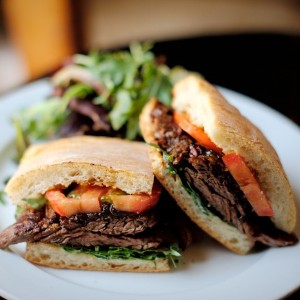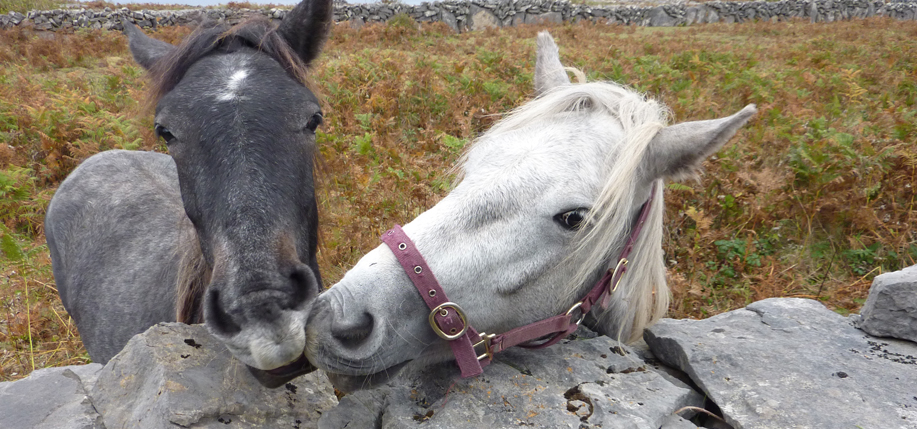Irish horses are much more than the stuff of legend
It is spring. The foals are being born. In their gawky, long-legged honor, I give you the saga of the Irish and their horses. It is a history that stretches across centuries. It is a tale of friendships and working partners. It is a romance born of the land, nurtured by necessity, and fastened by ancient bonds. It is one of the oldest love stories on earth.
Horses arrived in Ireland long before it became an island. At the end of the last ice age, a land bridge connected Derry to Scotland and another joined England with France. From the Asian steppes where the horse originated, herds migrated west across Europe and into Ireland. Remains found at Lough Gur, County Limerick, and Newgrange, County Meath, indicate that the Irish had domesticated horses before 2000 B.C.
In the Táin Bó Cúailnge (literally “The Cattle Raid of Cooley,” found in the Book of Leinster), the great warrior Cú Chulainn rode a chariot pulled by two horses that were equal in size, beauty, and speed. The right-hand horse was grey, broad in the haunches, fleet, and wild. The other was jet black, his head firmly knit, his feet broad-hoofed and slender. The swiftness of these steeds was so superior that even the best Ulster horses could not catch them.
In another tale from the same source, a man named Crunnchu bragged that his wife could run faster than King Conchobar’s horses. Rather than executing Crunnchu for his boasting, the king offered to let the woman race his steeds even though she was pregnant. At the king’s court Crunnchu’s wife was greeted with jeers. When the race began, the woman ran like the wind and crossed the finish line before the royal horses reached the halfway mark. Then as calmly and quickly as she had run, she gave birth to a set of twins. It was a sucker’s bet. The woman was none other than Macha, the Celtic horse goddess.
A story about the Celtic goddess Rhiannon also concerns horses. One day, while she was out riding her magical white steed, a prince tried to capture her. Every time he drew near, she sped off and left him in her dust. Finally, it occurred to the prince that maybe he should just ask her to please wait. The polite request was exactly what Rhiannon had been wanting to hear. When he trotted up beside her, she chuckled, “It would have been far better for your horse had you asked long before this.”
Among the multitude of Irish fairy beings there is a creature known as a Pooka. It can appear in many guises, but the most common is a large white horse. The spirit’s main purpose is to carry people away on a wild ride. In 1992, the Pooka was the subject of Into The West, a wonderful feature film in which a mysterious white stallion carries two gypsy children on a journey of self-discovery that begins in Dublin and ends at the shore of the wild western sea.
But Irish horses are much more than the stuff of legend. Like tourism and whiskey, bloodstock breeding is one of Ireland’s most important industries. This vital economic resource centers on three breeds: the Connemara pony, the Irish draught, and the thoroughbred.
The Connemara is the oldest pure Irish breed. Small native ponies called “breakers” were crossed with two imports, Welsh mountain ponies, which arrived with traders in the seventh century A.D., and Spanish Andalusians brought in a thousand years later. The Connemara’s size and sure-footed agility made them ideally suited for harvesting and hauling turf from the bogs of west Galway. In recognition of their historical importance, the Irish government provides a £500 grant for every pure Connemara foal born.
The Normans came to Ireland with large-boned horses which had been bred to carry armored knights. These huge mounts resembled massive Clydesdales and were bred with another small native horse, the Hobby. The cross-breeding produced an entirely new breed: the Irish draught. This hefty workhorse is tough, agile, intelligent, and well-mannered. It was ideally suited to farm labor, and, until tanks replaced cavalry, it was the preferred steed of Europe’s military units. Today, the Irish draught is prized as one of the world’s finest show jumpers.
The Connemara and the Irish draught have both left deep hoof-prints in Irish history, but it is the thoroughbred race horse which has become a multi-million dollar business. Part of the reason is environmental – the limestone rocks that pepper every Irish field leach calcium into the soil. Year-round rainfall produces lush grass. Horses raised in the calcium rich pastures develop exceptionally strong, healthy bones. The other half of the equation is simple. The Irish love a good horse race.
With dozens of racetracks scattered about the island, there is a horse race somewhere in Ireland nearly every day of the year. The most famous track of all is the Curragh Racecourse in County Kildare. In the earliest manuscripts, the Plains of the Curragh (Old Irish: An Corragh) are named as a place of sport for Celtic kings and their people. After the Norman conquest, it was made a royal common, and in the 13th century its very surface was protected by law from destructive grazing.
In the 17th century, the Curragh became a sporting resort for Ireland’s chief governors and administrators. The vast majority of King’s Plates races were contested there, and it became the social center of Irish racing. By the end of the 18th century, the Curragh was fringed by the lodges and stables of Ireland’s most prominent owners, breeders and trainers. The most famous was Colonel William Hall-Walker, the talented jockey son of a Scots brewing family.
In 1900, Walker purchased a farm at Tully, where he began breeding race horses. Some have called “Willie” Walker’s methods eccentric; others laud his genius. Believing that the stars dictated the destiny of all living creatures, he incorporated skylights above every stall so that the moon and stars could exert maximum influence on the horses. The astrology of each foal was recorded at birth. Those with unfavorable horoscopes were sold, regardless of lineage. After fifteen years of extraordinary success, the colonel gave his farm to the British Crown for the purpose of founding a national stud. In 1943, it was purchased by the Irish government. Today, the Irish National Stud Company promotes the Irish bloodstock industry by providing the services of its stallions to horse breeders from all over the world.
In the early days of the United States, millions of Irish emigrated to America and many families settled in the South. They built great plantations (think Tara, Scarlett O’Hara, and Gone With The Wind), and they bred horses for sport, pleasure, and prestige. With the Civil War, the South’s plantation empire crumbled, but its horses lived on.
Two of the world’s most famous Thoroughbred races are scheduled in May and June: the Irish Derby at the Curragh (June) and America’s Kentucky Derby at Churchill Downs (May). Both races date from the 19th century, both have million-dollar purses, both feature the best of Irish bloodstock, and both have strong food traditions.
Everyone knows that the Kentucky Derby’s official drink is the mint julep. A lesser known racetrack treat is Ireland’s bookmaker sandwich. May I suggest that you consider pairing them? Like horses and the Irish, they go together supremely well. Sláinte! ♦
RECIPES
The Bookmaker Sandwich
 Note: Before the days of computers, the Internet, and cell phones, an Irish bookmaker was so busy taking bets on the races that he couldn’t stop long enough for a leisurely meal.
Note: Before the days of computers, the Internet, and cell phones, an Irish bookmaker was so busy taking bets on the races that he couldn’t stop long enough for a leisurely meal.
1 long crusty loaf of bread, Vienna style
1-2 tablespoons butter
1 pound sirloin steak
mustard
salt and pepper
Slice the loaf in half lengthways and butter it well. Cut the steak lengthwise in two, rub with butter, sprinkle with salt and pepper. Grill the steak under hight heat but do not overcook. Put the meat strips straight away onto the buttered half loaves. Season with salt and pepper and spread with mustard. Put the two halves of the sandwich together. Place on foil, wrap tightly and put a light weight on top. When cool cut into fairly thick slices, put back together and wrap again. The steak juices absorb into the bread and will keep it moist. Serves 3-4.
(Irish Traditional Food / Theodora Fitzgibbon)
The Mint Julep
1 cup water
1 cup sugar
1 large bunch fresh mint
Kentucky bourbon
crushed ice
spring water
extra mint sprigs for decoration
sipping straws
Fill a large jar loosely with mint sprigs. Set aside. Combine sugar with water in a stainless steel saucepan and make a simple syrup by boiling together for 5 minutes. Remove from heat and let syrup cool. While syrup is still warm (but not so hot it will crack the glass) pour over mint to cover. Let cool completely, then cap and refrigerate 24 hours. Discard mint. Keep refrigerated until ready to use.
Pre-chill 8 oz. glasses at least one hour before they will be needed. When you are ready to serve, fill glasses with crushed ice. Into each glass pour: one tablespoon mint syrup, one tablespoon spring water, and two ounces Kentucky bourbon. Stir gently until glass is frosted. Garnish with extra mint springs and a sipping straw. Serve at once. Makes 8-10 juleps.
(Personal recipe)


Thanks
Thank you
What are your sources for the origins of the Connemara Pony and the Irish Draught?
Yeah that’s what I’d like to know